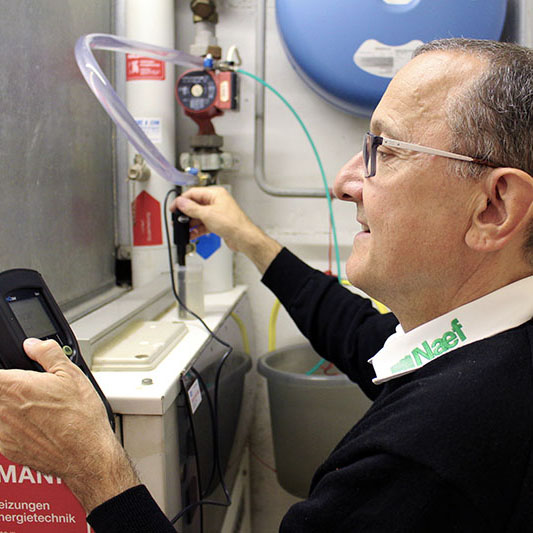Renovate underfloor heating using the original
Between 1970 and 1990, floor heating made of simple plastic was often installed, enabling strong oxygen diffusion. The resulting accumulation of sludge and aging-related embrittlement lead to reduced heat output over time. Leaks can even occur if you wait too long. With the inexpensive HAT system, your underfloor heating will be sustainably renovated, without the need for a construction site. Our professional status analysis will give you a solid base to make decisions in advance.
Our analysis will give you clarity

Romeo Geissberger Head of the HAT system department during status analysis
A preventive analysis provides clarity about the condition of your underfloor heating, and is performed onsite by one of our specialists. Once we have evaluated set parameters, we will recommend what action is to be taken. This will either serve as a basis for a renovation or will give your setup the all-clear.
Our experts analyse a total of six values and assess them based on applicable SWKI guidelines. If there are significant deviations from the defined guideline values for one or more parameters, we will work out proposed solutions for your system. You will receive a detailed analysis protocol from us with a catalogue of measures so that everything is transparent and that you have a solid base for decision-making. We take thermographic recordings using a thermal imaging camera to supplement the analysis and reveal deficiencies in heat distribution.
Calculator status analysis
Enter your zip code and calculate the price
A status analysis at your home costs: – – –
The problem with underfloor heating
Since the early 1970s, underfloor heating has been installed in the majority of new Swiss buildings. Until 1990, plastic pipes were usually installed. These are subject to embrittlement and silting and can cause problems after just 30 years. It is important to recognise these at an early stage and to take the necessary steps to protect them. We can renovate your underfloor heating if necessary. Since about 1990, multi-layer composite pipes have been used, which, thanks to their aluminium core, are much more durable.
Problems are mainly caused by simple, first-generation plastic pipes, which were installed until 1990. Oxygen molecules pass through the walls of the plastic pipes and attack metal parts such as fittings and boilers. The residue from such corrosion forms a tough sludge that collects everywhere in the heating circuit. The pipes are also constantly exposed to thermal fluctuations. This accelerates the evaporation of stabilisers in the plastic. The result is embrittlement: a creeping process that you won’t notice at first. However, over the years, brittleness can cause hairline cracks in pipe material, which are noticeable in the form of pressure loss in the heating system.
The oxygen input, which increases with embrittlement, causes further corrosion processes on the metal components, while the sludge progresses. Higher flow temperatures usually compensate for the heating’s decreasing efficiency. It is a vicious circle, as this further accelerates the embrittlement process of the plastic. The heating circuits are even more stressed by the excessive operating temperature. Leaks and water damage then crop up, and it becomes inevitable that the entire underfloor heating will need to be replaced at some point. Therefore, you should have a professional condition analysis carried out if you see the following signs.
Sustainable renovation of underfloor heating using the HAT system
Is renovation necessary and feasible according to the status analysis? Then we can offer you the original HAT system for interior underfloor heating renovations. We have been renovating old floor heating pipes since 1999, making them diffusion-tight in accordance with DIN 4726. And all without the need for a construction site.
The first step in a renovation is to completely dry the pipes with specially prepared compressed air. This is followed by internal cleaning with a gentle, chemical-free, delicate finish inside the pipes, to remove mud residues and incrustations. Each pipe is then evenly coated from the inside using a specially developed coating material. Once it has been left to dry for 48 hours, this coating will have created a new pipe within the old one, which can then connect to the existing plastic pipe. The coating provides long-term protection for the old underfloor heating and makes it waterproof against any diffusion in accordance with the DIN 4726 standard. We are the only company that can provide this level of work. We renovate underfloor heating within a very short period of time and with a minimum of noise and dirt emissions. A pipe renovation is around 10 times faster and much cheaper than a total replacement. You can still use your rooms during the renovation work. With our HAT system, we can demonstrably extend the functionality and durability of your underfloor heating by at least 20 years.
The problem with underfloor heating
Analysis of underfloor heating
Renovation using the HAT-System



























